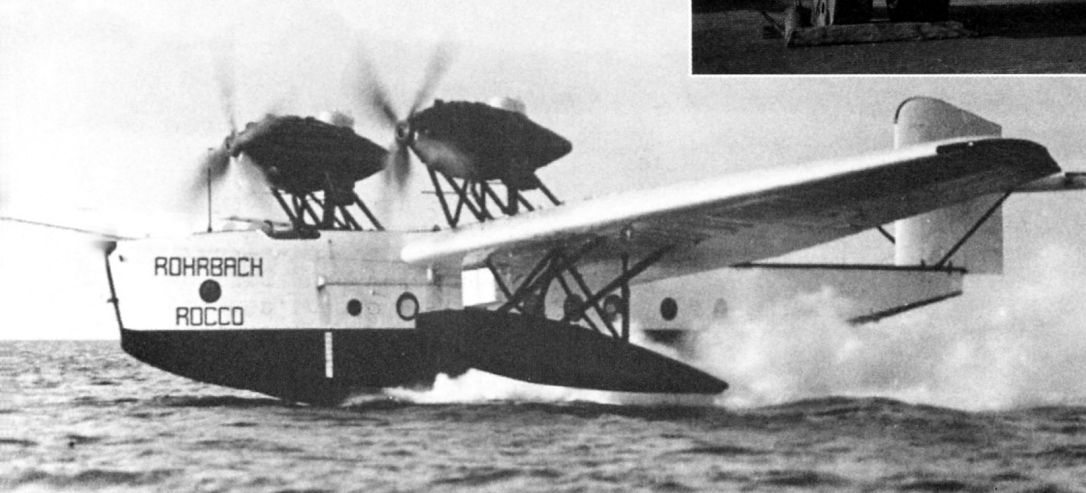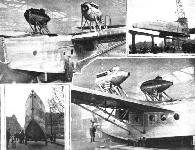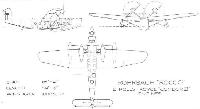Flight, May 1927
THE ROHRBACH "ROCCO" FLYING-BOAT
New German Commercial Machine with Two Rolls-Royce "Condor" Engines
DR. ROHRBACH, the famous German aircraft designer, has named his latest type of flying-boat "Rocco." We are not quite certain what is the exact meaning of this word, or whether it has any meaning, in German, but from the size of the boat to which it is applied it would appear reasonable to assume that it is the equivalent of the English "Roc," described by Webster as "A fabulous mythical bird of Arabia, so huge that it bore off elephants to feed its young." We do not know if Dr. Rohrbach has any intention of indulging in this particular form of baby-snatching with his new flying-boat. At any rate, it scores off the Roc of Arabia in being a long way from being mythical. In fact, there is something quite offensively real about it. Like most Rohrbach machines, certainly all Rohrbach flying boats, the “Rocco" is an ugly beast, what with its slab-sided boat hull, high free-board and narrow beam. But it seems that it is a flying-boat meant for serious business, so that one may forgive any shortcomings in the matter of appearances. For the matter of that, our modern liners are not exactly things of beauty compared with the old full-rigged ships, and in this mechanical age utility is apt to come before looks, although a few inspired aircraft designers have managed to retain the one without sacrificing the other.
In its general design and construction, the Rohrbach “Rocco” is similar to the series of flying-boats previously designed by Dr. Rohrbach, but the effect of evolution is traceable in the design. Thus, in place of the constant-chord, constant-section wings of the early Rohrbach, the wings of the "Rocco" have tapered tips. Fundamentally, however, the new boat is typically Rohrbach, with a monoplane wing surmounted by two engines, a flat-sided narrow beam hull steadied when on the water by two outboard wing floats. A large dihedral angle is a feature of the design, this doubtless being a result of the high position of the engines.
Constructional Features
As in the case of earlier Rohrbach flying-boats, the "Rocco" is of all-metal construction, the term "all-metal" in this case being synonymous with duralumin construction, which is the material used exclusively with the exception of a few wing fittings and bracing struts, which are of steel. A feature of Rohrbach construction is that the covering or skin, as it is usually called in modern aircraft parlance, is designed as a stress bearing part of the general structure. This applies of course, to flying-boat hulls in general, but in the case of the Rohrbach machines, it also applies to the wings, which are covered with sheet duralumin forming part of the wing box. This wing box may be considered as one very large spar, extending from tip to tip of the wing and, in a fore and aft direction, very roughly half-way in the wing chord to a short distance aft of the leading edge. This wing box is built up in the form of a front and rear member corresponding approximately to the front and rear spars in more orthodox types of construction, joined at intervals by fore and aft bulkheads or formers, the skin being riveted to both spars and formers. In addition, the thickness of the skin varies from point to point in the wing according to local stresses, the change being effected partly by using sheet duralumin of different gauges and partly by lamination.
The more or less closed box construction of the Rohrbach wing has necessitated a somewhat unusual arrangement of the leading and trailing edges. These are hinged to front and rear spar at short intervals, and are attached in such a manner that by undoing a number of small bolts the leading and trailing edges can be swung up or down in such a manner as to enable an inspection of the interior of the wing box to be made, or even minor repairs to be effected. Also, should any sea water have got inside the wings, in taxying in a very rough sea, for instance, the water can be drained out, and leading and trailing edges opened so as to enable air to get at the interior of the wing and dry up any water that may have collected in out-of-the-way corners.
The boat hull is of the fiat-sided variety, this form evidently having been chosen in order to avoid as far as possible the somewhat expensive panel beating which is necessary where sheet material has to be bent over a double curvature.
An exception is formed by the planing bottom of the hull, which, in the latest type of Rohrbach, is of pronounced "V" formation, the flat-bottomed hulls of the earlier Rohrbachs having, we believe, given a certain amount of trouble owing to leakage as a result of hard landings. There are two steps in the hull, as in most modern flying-boats, the steps being of the closed variety.
In the detail construction of the hull, as well as in that of the wings, only flat sheet and open sections are employed in order to afford cheap construction and ease of inspection. Thus, it is claimed that no hidden rivets are found anywhere in the structure, all riveting being open to inspection from both sides. Furthermore, both during actual construction and in use later on the open sections employed render the operation of protecting the material against corrosion easier and more certain. A number of bulkheads divide the boat hull into watertight compartments, and all the doors in the cabin are so made as to be watertight when closed, thus reducing the risk of sinking in case of damage in one compartment, It is even claimed that the buoyancy of the hull is such that with all doors and windows closed the machine would remain afloat with two adjacent compartments damaged.
A similar principle applies to the outboard wing floats, and as a safeguard against the machine turning over in case of damage to a wing float the outer few feet of the wing itself have been formed into watertight boxes, so that if a wing float is punctured, and the machine begins to heel over, the wing tip will meet the water, and by the buoyancy of the wing tip boxes, acting on a long lever arm, will effectively prevent the machine from turning right over, although it would naturally be over at a rather uncomfortable angle.
Hull Accommodation
The boat hull of the Rohrbach "Rocco" is, as already mentioned, divided into a number of compartments. The nose of the boat forms what is termed a "collision compartment," which is separated from the rest of the boat by a watertight bulkhead. In this compartment is carried the gear for handling the machine on the water, such as anchor ropes, boat hooks, drogues, etc. This collision compartment would protect the rest of the boat in case of accidental ramming of any obstacle resulting in a leak in the forward part of the hull.
Aft of the collision bulkhead is the pilot's cockpit, in which are placed two seats side by side, and all the controls, instruments, etc. Owing to the situation of the cockpit ahead of the wings, the view is particularly good in all directions, especially as the boat hull is of relatively narrow beam.
Behind the cockpit is the wireless compartment, which has a length of 0-92 m. (3 ft.) and a width of 1-5m. (4 ft. 11 ins.). In addition to the wireless outfit, table, seat, etc., this compartment also contains the auxiliary engine, which is so arranged as to reduce the noise of it to a minimum, by being housed inside a sound-proof compartment. The auxiliary engine is a Bristol gas starter, which, in addition to its main function of starting the engines, is also employed for driving the electric generator and the bilge pumps.
The saloon has a length of 6-8 m. (22 ft. 4 ins.) and a width of 1-7 m. (5 ft. 7 ins.) and there is ample head room for standing upright throughout. A watertight bulkhead divides the saloon into two separate compartments with a watertight central door giving communication between the two. The forward compartment has accommodation for four passengers and the aft one for six. Entrance to the saloon is through a hatchway in the deck of the hull at the aft end of the saloon. The saloon is covered with leather and other material which is so arranged as to absorb a considerable amount of the noise from the engines. The seats have adjustable back-rests and are claimed to be extremely comfortable. The windows of the saloon are in the form of round portholes and like the various doors and hatch covers, are so made as to the watertight when closed. The saloon is well ventilated and heated and by each passenger's seat there is an electric light.
Aft of the cabin is a lavatory and aft of that again is the luggage and goods compartment, which is entered through a hatch in the deck, and which measures 1-5 m. (4 ft. 11 ins,) in length with an average width of 1-3 in. (4 ft. 3 ins.). Special provision has been made for lashing the luggage in such a way as to prevent it from shifting.
Power Plant
The engines used in the Rohrbach "Rocco" are Rolls-Royce "Condors" Series III of 650 h.p. each. They are supported on tubular structures above the wing and neatly cowled in. It is claimed that with this high position of the engines, the tractor air screws are well clear of any spray that might be thrown up in a rough sea. Behind the engines and inside the cowling are the two oil tanks, while the petrol tanks form the leading edge of the wings near the hull. It is claimed that by having no petrol in the hull and with the tanks exposed in this manner, there is practically no fire risk, as any petrol fumes are instantly blown away. Needless to say, however, fire extinguishers are carried and all the usual precautions taken against fire. The low position of the tanks in relation to the engines has, of course, necessitated the use of petrol pumps, but it is claimed that these are now so reliable that little added risk of breakdown of the petrol system arises through their use. The modern practice in this country is, of course, to place the petrol tanks on the top plane, but in a monoplane like the Rohrbach this was naturally not possible, and instead the designer has chosen the arrangement described.
A very complete wireless equipment is carried on board consisting of sending and receiving apparatus for both telephony and telegraphy. When the machine is in flight the necessary current is produced by a windmill-driven generator, but another generator is carried in the hull and driven by the Bristol gas starter, so that should the machine be forced to descend, a small wireless pole carried on board can be erected and messages sent out from the auxiliary aerial. Dr. Rohrbach was, we believe, the first designer to provide masts and sails for a flying-boat, so that in case of total engine failure the machine should be able to proceed under sail to the nearest coast or port, and in the "Rocco" such an equipment is provided.
Specification
Following are the main characteristics of the Rohrbach “Rocco" :-
Length, o.a. 19-3 m. (63 ft. 3 ins.)
Wing span 26 m. (85 ft. 3 ins.).
Wing area 94 sq.m. (1,010 sq. ft.).
Tank capacity 3,800 litres (836 galls.).
Weight of machine bare 5.790 kg. (12,750 lbs.).
Service equipment 200 kg. (440 lbs.).
Total empty weight 5,990 kg. (13,190 lbs.)
Fixed equipment 460 kg. (1,010 lbs.).
Loose equipment 400 kg. (880 lbs.).
Crew of 3 250 kg. (550 lbs.).
Consumable load 1.600 kg. (3,520 lbs.).
10 passengers 750 kg. (1,650 lbs.).
Luggage 150 kg. (330 lbs.).
Total load carried 3,610 kg. (7,940 lbs.).
Total loaded weight 9.600 kg. (21,130 lbs).
Permissible overload 900 kg. (1,980 lbs.).
Highest permissible total loaded weight 10,500 kg. (23,110 lbs.).
Full speed at sea level at normal load 220 km./h. (136-5 m.p.h.).
Cruising speed 168 km./h. (104-3 m.p.h.).
Landing speed 115 km./h. (69-3 m.p.h.).
Climb to 1,000 m. in 5-8 mins.
Absolute ceiling 3,150 m. (10,350 ft.).
Range with normal load and at cruising speed 1,300 km. (808 miles).
Range at full permissible load with full tanks and at cruising speed 2,400 km. (1,490 miles)
These figures are guaranteed to ± 5 per cent.
Показать полностьюShow all









